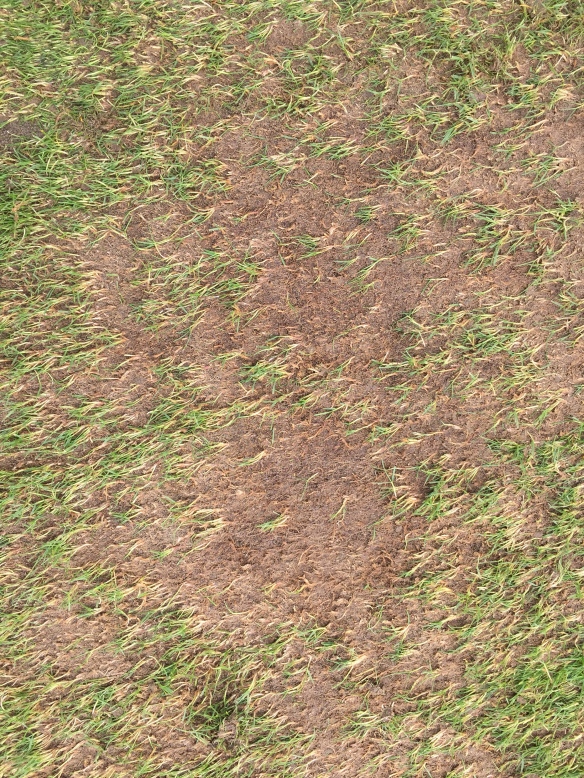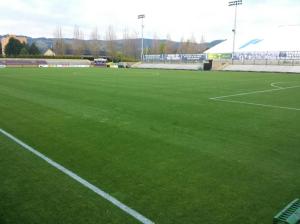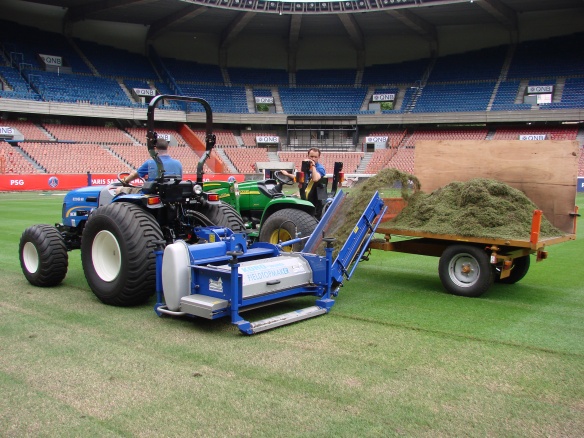
Solutions and possibilities. These were the theme for the first ever Celebration Bermudagrass Technical Management School last week. Celebration Management School took place in 3 locations in Florida and featured extensive information exchange and idea generation. The Management School was based around the expanded possibilities of Celebration bermudagrass and how the unique varieties helps meet the demand for high traffic natural grass fields. The school curriculum focused in on specific protocols and approaches for maintaining Celebration under high traffic and limited rest time. It was a privileged for me to join Mr. John Chapman as one of the teachers for the school!
Each day’s venue provided a unique perspective. Each has a unique venue for an athletic field school and a different perspective on high traffic Celebration bermudagrass. The South Florida event was held at the Spanish River Library in Boca Raton, followed with a tour of de Hoernie Soccer Complex in Boca. The west Florida event was held at the Sarasota Polo Club in Sarasota, FL. And the central Florida event was held in the City of Orlando City Council Chambers with a tour of the high traffic public park/ open space at the Dr. Phillips Performance Arts Center. Soccer, polo, and public space for all activities. The high traffic, challenging demands that we all were able to observe Celebration sustaining growth and recovery under were all very unique.
Some of the initial highlights from the school included:
- Encouragement to think outside the box and try new things, with Celebration maintenance and with natural grass field maintenance overall
- Introduction to multiple examples of Celebration bermudagrass performing as the strong, durable, reduced input grass that meets the demand even under high traffic
- Exploration of why and how Celebration bermudagrass has set itself as the standard bermudagrass to meet the demand of high traffic fields in the South

Advancing into the technical information of the Celebration Management School, John Chapman and myself (along with unprecedented group participation) explored:
- The simplicity and importance of mowing 2+ times per week at 1” or below to promote density, increase durability, reduce thatch accumulation potential, and provide natural weed control
- A wide range of aeration techniques for meeting the demand for high use and promote Celebration’s ability to root up to 5’ in 1 year. Video examples supported the explanation of each aeration type to create a demonstration environment for participants.
- How surface aeration and de-compaction aeration are 2 very different types of aeration. Real world data was supplied to illustrate how GMax reduction and infiltration rate increase differs with each.
- Multiple cultivation tools to reduce/ remove thatch accumulation and promotion of lateral growth to increase density and durability. The tools range from simply brushing with a tow behind brush or brushes on the front of reels or decks to verticutting and even Universe® Fraze Mowing.
- The importance of planning and combining aeration and cultivation practices to ensure maximum benefit with each and every practice that takes place.
- Understanding that June, July, and August are the prime time to encourage and establish bermudagrass strength and root depth to support against high use all year round.
- Soil testing results and why having data for plant available nutrients is as important as overall nutrient content in the soil.
- Fertilizer technologies and techniques to promote consistent, healthy, strong Celebration growth nearly all year round.
- Reinforcement of why durable, strong Celebration growth requires a maximum of 3-5 lbs N/ year and how most of that N should come from a slow release source of N
- Potassium’s importance, leading to the need to keep yearly N:K ratios and 1:1 or 1:1+
- Foliar feeding and how during periods of stress, especially fall, winter and spring, foliar feeding will act as a medical IV to support for Celebration growth and recovery.
- How humic acid supports soil health and the battle against soil compaction from high use

Celebration Management School students shared many examples of success with each topic. The interaction between participants and we as teachers was nearly the best I have ever experienced. Because of that, multiple points were created and raised:
- Approaches for using growth regulators to 1) increase density and durability along with 2) decreasing mowing.
- Using a moisture meter to track soil moisture to better manage irrigation and to track to what depth proper soil moisture is being reached during different times of the year. That moisture meter can also be used to create a standard for field closure protocols for rain.
- Celebration has a strong ability to sustain growth in a wide range of soil pH conditions
- Flushing during times of drought in Florida is vital to wash down salt and/or bi-carbonate build ups that come from poor quality irrigation water in the state.

The end section of Celebration Management School shared ideas and featured dialogue between students in reference to Celebration’s ability to sustain winter growth and recovery:
- Celebration is a “shade tolerant” bermudagrass. Shade tolerance indicates Celebration micromole requirement for light is lower than most all other bermudagrass. Thus winter’s short day length (example, Dec. 21 is the shortest day of the year) and low sun angle (sun is low on the horizon) do not cause Celebration to go dormant like other bermudagrass varieties
- Because Celebration can survive low light conditions, tools like dye and paint can be utilized to absorb heat and promote growth
- Grow tarps/ blankets, used regularly on fields in the central and northern part of the USA but not in Florida, can be excellent tools to generate heat and regeneration for Celebration during cooler winter months.
- Results were share and examined from a University of Florida trial on the impact of a range of colors of topdressing sands to promote heat and growth. Those results are dramatic, and the trial is ongoing. The information is very valuable for supporting winter growth.
- Re-visit to points made previously on foliar feeding in the winter to support Celebration plant systems.
- Also re-visiting fertilizer technology and explanations of organic fertilizer/ mineral fertilizer blends work well in the winter to encourage soil microbes and generate heat
- Overseeding: To overseed with ryegrass or not overseed with rye grass. Celebration’s aggressive nature allows it to transition back to 100% bermuda faster and with less inputs.
- Celebration’s winter tolerance allows can allow for reduced overseeding rates
The discussion about deciding to overseeding or not to overseed was excellent. Ultimately, a Sports Turf Manager must balance what is best for the grass with what is best for the playability of the field. The majority of the group decided (with encouragement from the teachers) that playability and safety come #1, ahead of our desires to do what is best for the grass. With Celebration, overseeding is possible because it transitions quickly and aggressively.

In closing the Celebration Technical Management School, participants were challenged with case studies for Celebration natural grass fields. Two scenarios of specific situations, time, and traffic demand were supplied. Participants split into groups where they worked to create their own management suggestions in reference to 1) mowing 2) cultivation 3) plant feeding and 4) additional comments for overall maintenance to meet the challenge. The case studies allowed participants to interact much like they do with them maintenance supervisors and staff each day while at the same to provided us as teachers with an assessment tool to ensure the participants would be able to utilize information ASAP in their own maintenance plan.
THANK YOU to all participants that joined us for Celebration Technical Management School. Ultimately, we hope each participant was able to take a a minimum of 1 actionable idea back with them to utilize immediately with their maintenance routine. THANK YOU for your positive attitudes and open minds. The possibilities for Celebration are amazing, no doubt you will continue to see amazing results and be able to build on those through this growing season!











